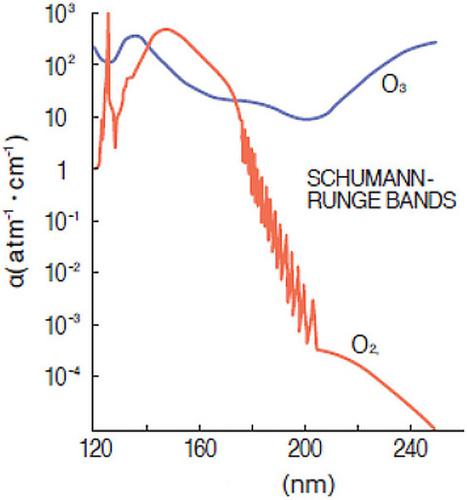当前位置:
X-MOL 学术
›
Photochem. Photobiol.
›
论文详情
Our official English website, www.x-mol.net, welcomes your
feedback! (Note: you will need to create a separate account there.)
Ozone Generation by Ultraviolet Lamps†
Photochemistry and Photobiology ( IF 2.6 ) Pub Date : 2021-02-03 , DOI: 10.1111/php.13391 Holger Claus 1
Photochemistry and Photobiology ( IF 2.6 ) Pub Date : 2021-02-03 , DOI: 10.1111/php.13391 Holger Claus 1
Affiliation

|
The COVID-19 pandemic has generated a great deal of interest in ultraviolet germicidal irradiation (UVGI) as an important means to disinfect air and surfaces. The traditional lamp employed for UVGI has been the low-pressure mercury-discharge lamp that emits primarily at 254 nm in the ultraviolet photobiological band UV-C (100–280 nm). The recent development of even shorter-wavelength UV-C lamps, such as the Krypton–Chloride, 222-nm lamp, has led to greater concerns about the UV-C generation of ozone. It is well known that wavelengths below 240 nm more readily generate ozone. However, there is a great misunderstanding with regard to the actual generation and dissipation of ozone molecules by UV-C lamps. A review of this subject is much warranted. An overview of the ozone generation of various UV-C light sources is presented to give users a better understanding of risk and how to assure control of ozone when employing UV-C lamps.
中文翻译:

紫外线灯产生的臭氧†
作为消毒空气和表面的重要手段,COVID-19大流行引起了人们极大的兴趣,即紫外线杀菌辐射(UVGI)。用于UVGI的传统灯是低压汞放电灯,该灯主要在紫外光生物波段UV-C(100-280 nm)中以254 nm的波长发射。甚至更短波长的UV-C灯(例如222 nm氯化rypto灯)的最新发展也引起了人们对UV-C产生臭氧的更大关注。众所周知,低于240 nm的波长更容易产生臭氧。然而,对于UV-C灯实际产生和消散臭氧分子存在很大的误解。对该主题进行复审是非常有必要的。
更新日期:2021-02-03
中文翻译:

紫外线灯产生的臭氧†
作为消毒空气和表面的重要手段,COVID-19大流行引起了人们极大的兴趣,即紫外线杀菌辐射(UVGI)。用于UVGI的传统灯是低压汞放电灯,该灯主要在紫外光生物波段UV-C(100-280 nm)中以254 nm的波长发射。甚至更短波长的UV-C灯(例如222 nm氯化rypto灯)的最新发展也引起了人们对UV-C产生臭氧的更大关注。众所周知,低于240 nm的波长更容易产生臭氧。然而,对于UV-C灯实际产生和消散臭氧分子存在很大的误解。对该主题进行复审是非常有必要的。











































 京公网安备 11010802027423号
京公网安备 11010802027423号